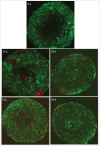Activated human primary NK cells efficiently kill colorectal cancer cells in 3D spheroid cultures irrespectively of the level of PD-L1 expression
- PMID: 29632716
- PMCID: PMC5889279
- DOI: 10.1080/2162402X.2017.1395123
Activated human primary NK cells efficiently kill colorectal cancer cells in 3D spheroid cultures irrespectively of the level of PD-L1 expression
Abstract
Haploidentical Natural Killer (NK) cells have been shown as an effective and safe alternative for the treatment of haematological malignancies with poor prognosis for which traditional therapies are ineffective. In contrast to haematological cancer cells, that mainly grow as single suspension cells, solid carcinomas are characterised by a tridimensional (3D) architecture that provide specific surviving advantages and resistance against chemo- and radiotherapy. However, little is known about the impact of 3D growth on solid cancer immunotherapy especially adoptive NK cell transfer. We have recently developed a protocol to activate ex vivo human primary NK cells using B lymphoblastic cell lines, which generates NK cells able to overcome chemoresistance in haematological cancer cells. Here we have analysed the activity of these allogeneic NK cells against colorectal (CRC) human cell lines growing in 3D spheroid culture and correlated with the expression of some of the main ligands regulating NK cell activity. Our results indicate that activated NK cells efficiently kill colorectal tumour cell spheroids in both 2D and 3D cultures. Notably, although 3D CRC cell cultures favoured the expression of the inhibitory immune checkpoint PD-L1, it did not correlate with increased resistance to NK cells. Finally, we have analysed in detail the infiltration of NK cells in 3D spheroids by microscopy and found that at low NK cell density, cell death is not observed although NK cells are able to infiltrate into the spheroid. In contrast, higher densities promote tumoural cell death before infiltration can be detected. These findings show that highly dense activated human primary NK cells efficiently kill colorectal carcinoma cells growing in 3D cultures independently of PD-L1 expression and suggest that the use of allogeneic activated NK cells could be beneficial for the treatment of colorectal carcinoma.
Keywords: 3D Spheroids cultures; Colorectal Carcinoma; Immunotherapy; Natural Killer Cells Activation; allogeneic human primary Natural Killer Cells.
Figures





References
-
- Haller O, Kiessling R, Orn A, Karre K, Nilsson K, Wigzell H. Natural cytotoxicity to human leukemia mediated by mouse non-T cells. Int J Cancer. 1977;20:93–103. - PubMed
-
- Herberman RB, Holden HT. Natural cell-mediated immunity. Adv Cancer Res. 1978;27:305–77. - PubMed
-
- Kiessling R, Bataillon G, Lamon EW, Klein E. The lymphocyte response to primary Moloney sarcoma virus tumors: definition of a non-specific component of the in vitro cellular hyporeactivity of tumor-bearing hosts. Int J Cancer. 1974;14:642–8. - PubMed
-
- Kiessling R, Klein E, Wigzell H. “Natural” killer cells in the mouse. I. Cytotoxic cells with specificity for mouse Moloney leukemia cells. Specificity and distribution according to genotype. Eur J Immunol. 1975;5:112–7. - PubMed
-
- Karre K. Natural killer cell recognition of missing self. Nat Immunol. 2008;9:477–80. - PubMed
Publication types
LinkOut - more resources
Full Text Sources
Other Literature Sources
Research Materials
